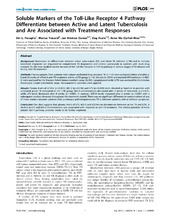Soluble Markers of the Toll-Like Receptor 4 Pathway Differentiate between Active and Latent Tuberculosis and Are Associated with Treatment Responses
Peer reviewed, Journal article
Published version

View/
Date
2013-07-16Metadata
Show full item recordCollections
Original version
https://doi.org/10.1371/journal.pone.0069896Abstract
Background. Biomarkers to differentiate between active tuberculosis (TB) and latent TB infection (LTBI) and to monitor treatment responses are requested to complement TB diagnostics and control, particularly in patients with multi-drug resistant TB. We have studied soluble markers of the Toll-like-receptor 4 (TLR-4) pathway in various stages of TB disease and during anti-TB treatment. Methods. Plasma samples from patients with culture confirmed drug-sensitive TB (n = 19) were collected before and after 2, 8 and 24 weeks of efficient anti-TB treatment and in a LTBI group (n = 6). Soluble (s) CD14 and myeloid differentiation-2 (MD-2) were analyzed by the Enzyme-linked immunosorbent assay (ELISA). Lipopolysaccharide (LPS) was analyzed by the Limulus Amebocyte Lysate colorimetric assay. Nonparametric statistics were applied. Results. Plasma levels of sCD14 (p<0.001), MD-2 (p = 0.036) and LPS (p = 0.069) were elevated at baseline in patients with untreated active TB compared to the LTBI group. MD-2 concentrations decreased after 2 weeks of treatment (p = 0.011), while LPS levels decreased after 8 weeks (p = 0.005). In contrast, sCD14 levels increased after 2 weeks (p = 0.047) with a subsequent modest decrease throughout the treatment period. There was no significant difference in concentrations of any of these markers between patients with pulmonary and extrapulmonary TB or between patients with or without symptoms. Conclusion. Our data suggest that plasma levels of LPS, MD-2 and sCD14 can discriminate between active TB and LTBI. A decline in LPS and MD-2 concentrations was associated with response to anti-TB treatment. The clinical potential of these soluble TLR-4 pathway proteins needs to be further explored.
